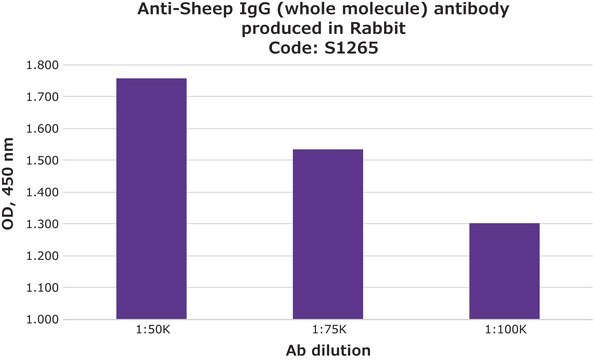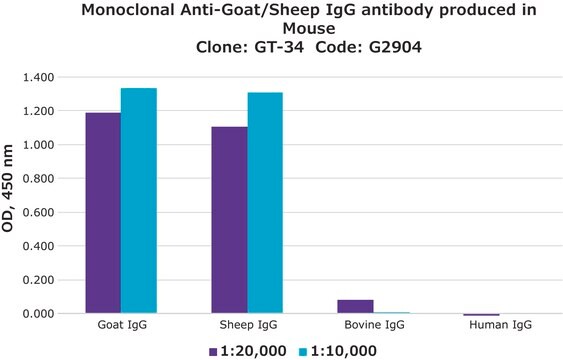S2763
Anti-Sheep IgG (whole molecule) antibody produced in donkey
affinity isolated antibody, lyophilized powder
Sinonimo/i:
Donkey Anti-Sheep IgG, Sheep IgG Detection
Autenticatiper visualizzare i prezzi riservati alla tua organizzazione & contrattuali
About This Item
Prodotti consigliati
Origine biologica
donkey
Livello qualitativo
Coniugato
unconjugated
Forma dell’anticorpo
affinity isolated antibody
Tipo di anticorpo
secondary antibodies
Clone
polyclonal
Stato
lyophilized powder
tecniche
quantitative precipitin assay: suitable
Temperatura di conservazione
2-8°C
modifica post-traduzionali bersaglio
unmodified
Applicazioni
Anti-Sheep IgG (whole molecule) antibody produced in donkey was covalently coupled with epoxy beads and used as control in immunoprecipitation.
Applications in which this antibody has been used successfully, and the associated peer-reviewed papers, are given below.
Immunoprecipitation (1 paper)
Immunoprecipitation (1 paper)
Azioni biochim/fisiol
IgG antibody subtype is the most abundant of serum immunoglobulins of the immune system. It is secreted by B cells and is found in blood and extracellular fluids and provides protection from infections caused by bacteria, fungi and viruses. Maternal IgG is transferred to fetus through the placenta that is vital for immune defense of the neonate against infections.
Stato fisico
Lyophilized from 0.01 M sodium phosphate, 0.015 M sodium chloride, pH 7.2.
Ricostituzione
Reconstitute with 0.135 M sodium chloride.
Esclusione di responsabilità
Unless otherwise stated in our catalog or other company documentation accompanying the product(s), our products are intended for research use only and are not to be used for any other purpose, which includes but is not limited to, unauthorized commercial uses, in vitro diagnostic uses, ex vivo or in vivo therapeutic uses or any type of consumption or application to humans or animals.
Non trovi il prodotto giusto?
Prova il nostro Motore di ricerca dei prodotti.
Codice della classe di stoccaggio
13 - Non Combustible Solids
Classe di pericolosità dell'acqua (WGK)
WGK 3
Punto d’infiammabilità (°F)
Not applicable
Punto d’infiammabilità (°C)
Not applicable
Dispositivi di protezione individuale
Eyeshields, Gloves, type N95 (US)
Scegli una delle versioni più recenti:
Possiedi già questo prodotto?
I documenti relativi ai prodotti acquistati recentemente sono disponibili nell’Archivio dei documenti.
Agnieszka Gambus et al.
The Journal of biological chemistry, 286(13), 11855-11864 (2011-02-02)
In late mitosis and G1, Mcm2-7 are assembled onto replication origins to license them for initiation in the upcoming S phase. After initiation, Mcm2-7 provide helicase activity to unwind DNA at the replication fork. Here we examine the structure of
Raiany A Freitas et al.
Life sciences, 262, 118552-118552 (2020-10-10)
Angiotensin-1-7 [Ang-(1-7)] is an essential peptide of the renin-angiotensin system that promotes benefits modulating effects in different tissues. Similarly, interleukin-10 (IL-10) exhibits an immunomodulatory action on the vasculature. This study aimed to evaluate whether Ang-(1-7) levels attenuates vascular contractile response
Soumya Palliyil
Methods in molecular biology (Clifton, N.J.), 1673, 325-352 (2017-11-14)
A number of bacteria use a class of chemical compounds called acyl-homoserine lactones (AHLs) as quorum sensing (QS) signals to coordinate their behavior at the population level, including pathogens like Pseudomonas aeruginosa. Blocking QS using antibodies is an attractive strategy
S Hashira et al.
Pediatrics international : official journal of the Japan Pediatric Society, 42(4), 337-342 (2000-09-15)
Maternal immunoglobulin G (IgG), transferred across the placenta to the fetus during intrauterine life, is an important component of the neonatal immunological defence mechanisms against infection. There is controversy with respect to differences in placental transfer of the different IgG
Il team dei nostri ricercatori vanta grande esperienza in tutte le aree della ricerca quali Life Science, scienza dei materiali, sintesi chimica, cromatografia, discipline analitiche, ecc..
Contatta l'Assistenza Tecnica.







